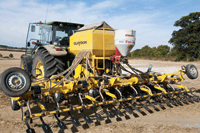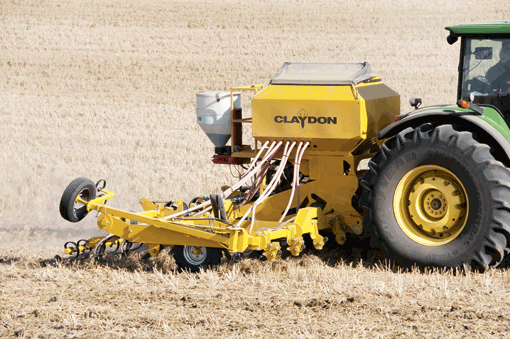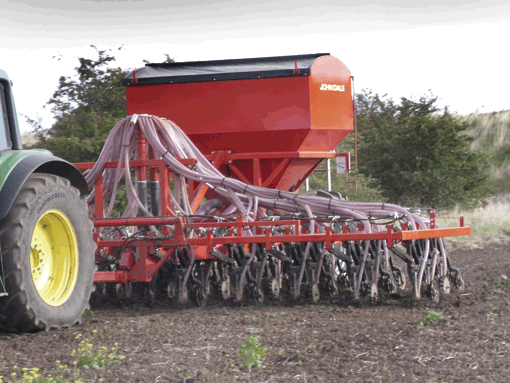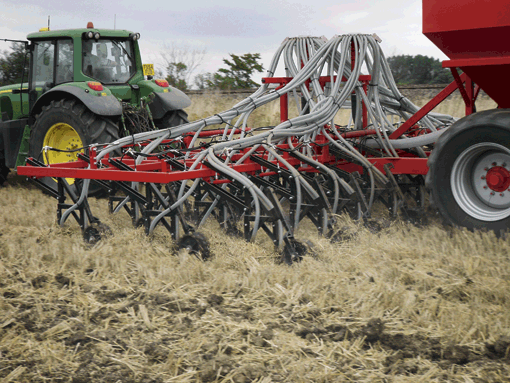Claydon and John Dale new drills profiled

It could have been so simple; design a drill, test it on the farm, convince other growers it’s just what they need, make a fortune supplying it.
Only it’s not as straightforward as that, as farmers-turned-machinery-makers Jeff Claydon and Edward Dale have come to realise.
Having both established a two-model range of drills, they have now developed new machines for this year’s sowing season to suit the requirements of growers for whom the existing designs are not quite ideal.
“In our case, we had the original V Drill in rigid and folding form, then the SR stone release model to cater for growers needing auto-reset tine protection,” notes Ollie Claydon. “But the tine and frame configuration prevented us folding a drill wider than 4m, so we produced the Hybrid to overcome that.”
The newest drill from the Claydon stable is a fully-mounted direct sowing implement again that sticks with Suffolk heavy land farmer Jeff Claydon’s philosophy but with different hardware.
 |
|---|
| Latest seed drill from Claydon is a 6m mounted folding unit with tine-plus-coulter assemblies and choice of shear pin or auto reset tine protection. |
It has already been built in 6m format, a 4.8m version is on the drawing board and both larger and smaller models may follow if it gets a good reception.
The tine arrangement, which sows seed in 180mm bands spaced 300mm apart to get plenty of light into the crop, is a common theme across all three drills.
A slim tine positioned ahead of the seed coulter work 150mm or so deep to break through any pan, ensure good drainage and create a localised tilth. The land in between is left intact with good carrying capacity for subsequent field operations.
“The tine coulter follows at 10mm to 35mm, placing seed on the shoulders of the furrow created by the leading tine,” Ollie Claydon explains. “That keeps the seed out of any excess moisture in the furrow but in a position where the roots can grow down into the loosened soil.”
The Hybrid has a tighter, more compact tine assembly that allows the drill to fold around the 1.25t capacity seed hopper – and it can be equipped with either shear bolt or hydraulic auto reset cultivator tine protection.
Behind the tines there is another change – in place of the pneumatic press wheels fitted on the other drills there is a paddle tine levelling bar of the type more usually seen along the front of a cultivator.
 |
|---|
| The Dale Eco Drill intended for growers who want to sow direct in some instances but also into minimum tillage seed-beds. |
“We’ve always advocated rolling 24-48 hours after sowing to give time for the ground to settle a bit rather than using a heavy press on the drill,” says Ollie Claydon. “This simply takes that idea a step further; the paddle tines are arranged to ease back any soil pushed up by the two tines and create a more level finish before consolidation.”
For Lincolnshire grower Edward Dale, developing a third seeder for his range of John Dale direct and mintill machines was simply a matter of offering fellow growers a further option.
“We already had the Zero Till, with fixed wide spacing and Seed Hawk tines for direct drilling and the All Till with close spaced tine assemblies of our own design for minimum tillage seed-beds,” he explains. “The Eco Till caters for growers who want to do some of each without having to run a separate machine.”
It caters for that with a knife coulter tine assembly that can be set to different row widths – using spacers rather than by sliding the coulter arms along the frame.
Each assembly comprises two tines on a parallel linkage, with either a semi-pneumatic tyre or a Guttler serrated steel roller providing depth control and post-sowing consolidation. The tyre is likely to be best on lighter soils, says Mr Dale, the cast roller on heavier ground.
“We advocate putting down some fertiliser,” he adds. “So the hopper is divided and the Accord metering system can send fertiliser to the front tine to place it deeper and about 25mm to one side of the seed placed by the second tine.”
Alternatively, the leading tine coulter and spacer blocks can be repositioned to sow direct into stubble in 125mm rows or in 75mm bands spaced 250mm apart.
 |
|---|
| Twin knife tines are located on parallel linkage and have screw depth adjustment. Spacers are used to set them up for conventional, band and wide row spacing to suit mintill and direct drilling. |
A useful change from the Seed Hawk assembly, he points out, is that the Eco Drill tines have a screw rather than a pin arrangement for adjusting the sowing depth. Also, the hydraulic cylinders that lift the tine coulters out of work can also apply some pressure if needed to ensure consistent penetration in dry, hard conditions.
The 12mm wide knife tines themselves are formed from boron steel with tungsten steel facing and despite getting “excellent penetration”, in Mr Dale’s words, they are said also to make the drill relatively easy to pull – a 6m units needs about 120hp, he reckons.
Given Mr Dale’s interest in confining vehicle passes to the same wheelings where possible, it is not surprising that the trailed Eco Drill is generously equipped in the wheel department. A pair of 710mm wide tractor tyres positioned beneath the hopper behind the coulter frame keeps compaction to a minimum.
Production plans include 4m, 6m and 8m units, including the possibility to extend a 6m drill to 8m in future, either to tackle extra acreage or to fit in with a controlled traffic system.
In summary
• Claydon Hybrid: Mounted direct drill using twin tine cultivate-and-sow system with shear pin or auto reset leading tine protection. Sows 180mm bands at 300mm centres. Sizes: 4.8m and 6m.
• Dale Eco Till: Trailed mintill or direct drill with twin tine coulters providing 125mm conventional, 75mm band or wide-spaced sowing. Sizes: 4m, 6m, 8m.

